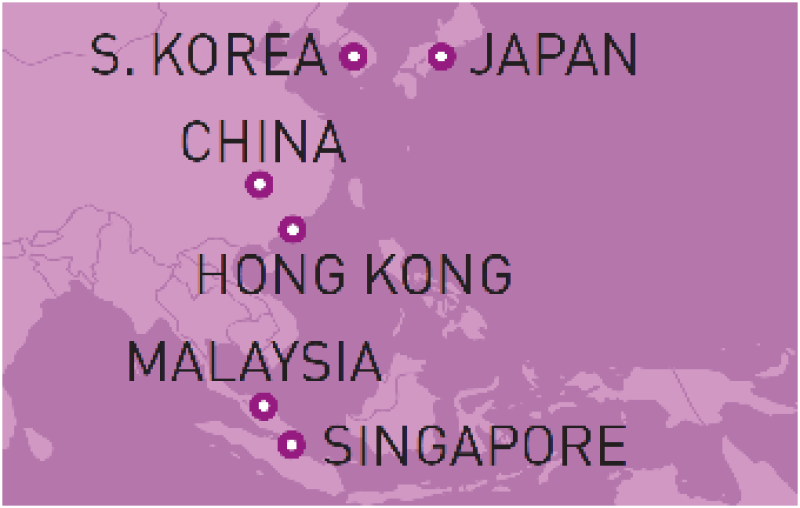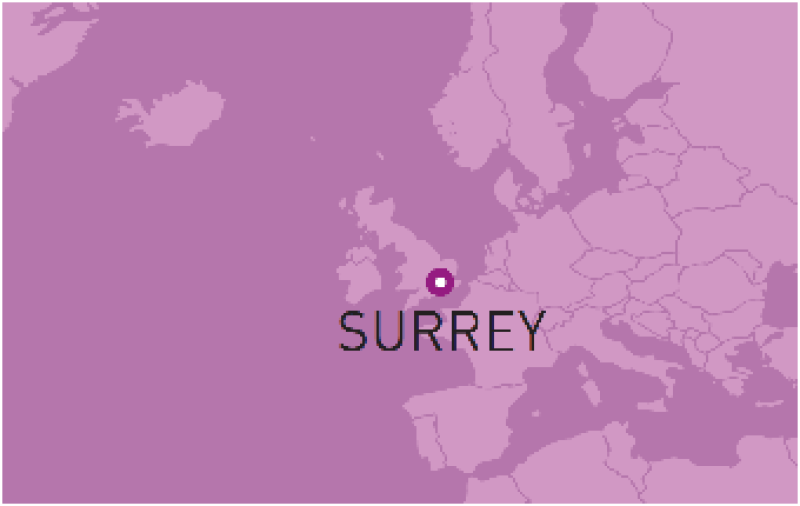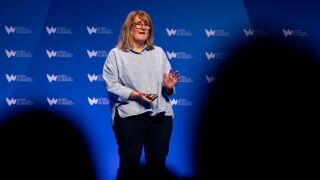
BACKER: Hibernia Networks
COMPLETION: Summer 2015
INVESTMENT: $300 million (approx.)
OVERVIEW: The Hibernia Express will be a 4,600km transatlantic submarine cable system spanning New York, US and London, UK. It will also connect Halifax in Nova Scotia, Canada, Brean in the UK, and Cork in Ireland. A six fibre pair cable, it will initially launch with 100Gbps transmission capacity.
A portion of the fibres will be optimised for extreme low latency and another portion optimised for 100x100Gbps design capacity. The project also includes terrestrial fibre at both ends of the route to extend connectivity to major metro areas.
POTENTIAL IMPACT ON MARKET: The first route to go live in the transatlantic market since Alcatel-Lucent and Vodafone’s Apollo cable in 2003, the Hibernia Express has a lot of expectations to meet.
Postponed in February 2013 following cyber-security concerns with its original vendor, Huawei, work resumed on the subsea cable in August 2014, when Hibernia Networks CEO, Bjarni Thorvardason, told Capacity that it had never considered “abandoning the Hibernia Express project, even for a second”. With its six fibre pair capabilities, the Hibernia Express is expected to be the fastest fibre-optic path between New York and London. But in an already crowded transatlantic cable market, what will make Hibernia’s offering stand out?
“Having a unique, low latency route combined with increased capacity allows Hibernia Express to offer unmatched services to trans-Atlantic connectivity customers,” Thorvardarson said.
The cable will bring a new level of competition to the transatlantic market and likely attract financial traders and enterprises with its low-latency specifications.
A number of new transatlantic cable projects have been discussed over the last decade, with none yet coming to fruition. Analysts at Terabit Consulting attribute this primarily to the challenging economic environment of their physical implementation, as well as existing competition.
“In addition, transatlantic capacity prices and the price of international managed bandwidth products in adjoining markets are among the lowest in the world, due in large part to the low cost bases of existing systems and robust competition among transatlantic capacity sellers,” the company said in a 2014 report on the transatlantic market.
But Hibernia Networks has deemed itself up for the challenge and as well as providing further capacity and route diversity to the transatlantic region, the company is also confident that its change of vendor from Huawei to TE Subcom will result in a high-quality and secure offering.
A specialist in the subsea cable field, TE Subcom began construction of the cable in mid-2014, and is using its C100 SLTE platform to provide a total cross-sectional design capacity of more than 53Tbps.
“Our company’s technology portfolio and extensive trans-Atlantic installation experience make us an ideal supplier for the Hibernia Express system,” said John Mitchell, president at TE Subcom.
“We are looking forward to tackling the special challenges of this unique project and supplying the newest high capacity, low latency cable across the Atlantic.”

BACKERS: MIIT, China Mobile, China Unicom, China Telecom
COMPLETION: Transfer of infrastructure by Summer 2015, process to finalise by mid-2016
INVESTMENT: $1.63 billion
OVERVIEW: A joint venture between China Mobile, China Unicom and China Telecom – established on July 18 2014 – China Communications Facilities Services (CFSC) will be an infrastructure firm, designed to facilitate the 4G roll-outs of China’s three largest operators.
The consortium will build approximately 120,000 telecoms towers for base stations, as well as relevant supporting facilities over the next three years. The company will establish branches or offices in 31 provinces, autonomous regions and municipalities, and will have seven departments and eight board directors.
POTENTIAL IMPACT ON MARKET: China Communications Facilities Services (CFSC) is set to support the migration of 4G in one of the world’s most exciting telecoms markets.
Designed to meet the infrastructure needs of its backers’ 4G roll-outs, the CFSC will focus on the construction, maintenance and operation of telecoms towers.
In a statement, China Unicom said that the new company will “reduce duplication and redundant construction of telecommunications towers and related telecommunications infrastructure in the telecommunications industry in China”.
When completed the telecoms giants could potentially reduce this duplicated construction by 40%, saving 30 billion yuan ($4.8 million) in funds and approximately 333.3 hectares of land, a source close to the deal claims.
China is the most highly populated country in the world, and last year, Michel Combes, CEO at Alcatel-Lucent, said that he expects China to become “the largest 4G market in the world”.
A report from the China Internet Network Information (CNNIX) concluded that by the end of 2013, China had more than 500 million mobile internet users, a growth of 80.9 million compared to the end of 2012. And with figures like this, the Chinese market will need robust and high-quality infrastructure to be able to support the demand as it continues to increase.
But despite many analysts viewing CFSC as a positive for the market given the resulting potential for capex savings, there are some who have raised concerns over China’s next big thing.
The mainland government of China in particular is said to be unclear over some aspects of its establishment “there are still more questions than answers on several key issues,” said Anand Ramachandran, head of telecommunications, internet and media equity research for Asia (excluding Japan) at Barclays.
Questions still hang over the number, quality and location of the towers which will be built, the valuation and consideration for these assets, as well as the lease agreements.
“All three operators seem to be broadly happy so far with the arrangements, but of course the devil is in the details,” Chris Lane, a senior analyst at Bernstein Research, told a local newspaper. “This joint venture will continue to generate controversy until the details are made clear.”
A joint venture between China Mobile, China Unicom and China Telecom – established on July 18 2014 – China Communications Facilities Services (CFSC) will be an infrastructure firm, designed to facilitate the 4G roll-outs of China’s three largest operators.
The consortium will build approximately 120,000 telecoms towers for base stations, as well as relevant supporting facilities over the next three years.
The company will establish branches or offices in 31 provinces, autonomous regions and municipalities, and will have seven departments and eight board directors.

BACKERS: Chunghwa Telecom, China Mobile, China Telecom, China Unicom, KT Corp, NTT Communications, Telekom Malaysia, Vietnam Posts and Telecommunications Group (VNPT), Philippine Long Distance Telephone Company (PLDT), Viettel, LG Uplus, StarHub, Time dotcom
COMPLETION: Q1 2015
INVESTMENT: $450 million
OVERVIEW: Spanning 10,400km, the trans-Asian submarine fibre-optic cable system will run between Malaysia, South Korea, Japan, Singapore, Hong Kong and mainland China. It was conceived to meet demand for intra-Asia connectivity. When the system goes online, it is slated to use 40Gbps channel, for a total design capacity of 54.8 Tbps per second. The cabling route was carefully chosen to avoid damage from natural disasters such as earthquakes and typhoons.
POTENTIAL IMPACT ON THE MARKET: At $450 million, the APG is one of the most expensive subsea cable systems in the world. Originally scheduled for the third quarter of 2014, the consortium has faced setbacks in bringing the $450 million project to fruition. Lack of funding and increasing competition from other consortiums launching cable systems, such as the Asian Submarine-cable Express and Southeast Asia Japan Cable, had resulted in the project almost being shelved.
That turned around in 2012 when social media giant Facebook and TIME dotCom, Malaysia’s second-largest fixed-line telecoms network, joined as investors. One of the key advantages of the new route is that it will provide Southeast Asian countries a more efficient method to route traffic to North America.
Existing cables are predominantly routed through Singapore or Japan. “This lowers our dependencies on Singapore as the main gateway for internet traffic,” said Saiful Husni, TIME DotCom’s CEO.
“We can now channel high volumes of this traffic on our network with the lowest latency, directly to the US.” Facebook’s investment in the infrastructure of the system is also significant. While it is likely to have reached a point of saturation in Europe and North America, the social media network’s growth in Asia is only just starting to kick in. In backing this cable, Facebook acknowledges that its Asian users are crucial to its continued growth.
Demand for international high-speed communications are increasing among enterprises and consumers in Asia, reflecting the expansion in to services such as cloud management and storage.
APG’s links to international capacity hubs such as Japan, Hong Kong, and Singapore, as well as emerging markets such as Vietnam, could make it the most strategic and diverse Asian cable system to date.

POPULATION: 11 million (July 2014 est.)
TOTAL LAND AREA: 109,820sqkm
INTERNET USERS: 1.6 million (2012 est.)
OVERVIEW: The US’ trade embargo on Cuba began in October 1960, a year after Fidel Castro seized power. Since then the country – with a population of around 11 million – has been largely left behind, with slow and censored access to the internet.
Only about 5% of Cubans have access to the open internet, according to Freedom House, a watchdog group. Until 2008, mobile services were only available to employees in state-run organisation or foreign workers. Cuba is the least developed telecoms market in the Carribean region and one of the most underdeveloped in the world.
The latest development in US foreign policy could change all that. US president Barack Obama announced at the start of the year a sweeping set of measures to significantly ease the 54-year-old embargo on Cuba.
POTENTIAL IMPACT ON MARKET: US president Barack Obama’s announcement could mark a momentous first step for US telecoms’ entry into the Cuban market. The US Treasury and Commerce Departments issued a package of new rules that will most significantly affect the areas of agriculture, banking and telecommunications.
In the telecoms sector, the administration will allow US telecoms operators to export equipment and other infrastructure projects needed to begin phone and internet services in the country.
Responses by US companies regarding business opportunities in the country have been mixed. In a statement, T-Mobile said it "will continue to look for ways to improve open communication as US policy evolves”. AT&T and Verizon are yet to comment.
Last year, a team of top Google executives, led by its executive chairman Eric Schmidt, visited the country to promote open internet access.
The country has seen some notable developments over the years. First was the activation of Alba-1 in 2013, a $70 million subsea cable that allowed Cuba to end its reliance on satellite-based internet services, increasing speeds and lowering costs.
The country’s state-controlled operator Empresa de Telecomunicaciones de Cuba (ETECSA) also announced plans to extend ADSL internet services to residential homes.
Could these developments signal a trend towards a more open market in Cuba?
Cuban telecoms infrastructure, however, still trails behind most of the world and will likely not be able to cope with a surge in internet traffic. Economic and political obstacles will also need to be overcome for open internet and mobile access to become a reality.
The nation’s telecoms market is largely dominated by ETECSA. It reported just under 2 million mobile phone users and 1.2 million landline users at the end of 2013, according to the Cuban News Agency.
“If the Cuban government is truly committed to opening up greater access to the internet for the Cuban people, its decision makers should carefully review the case study of Myanmar over the past three years,” Dough Madory, director of internet analysis at Dyn.

BACKERS: Aeroflex, Aircom International, BBC, BT, EE, Fujitsu Laboratories of Europe, Huawei, Ofcom, Rohde & Schwartz, Samsung, Telefonica, Vodafone
COMPLETION: September 2015
INVESTMENT: £46.6 million (approx. as of November 2014)
OVERVIEW: In 2012, the University of Surrey announced its plans for a 5G research centre. It has since attracted £11.6 million from the UK Research Partnership Investment Fund, followed by an additional £24 million from mobile operators and infrastructure providers such as Samsung, Rohde & Schwarz and Telefonica Europe.
Last November, Huawei, a founding member of the 5GIC, pledged a further £5 million investment towards the centre which will be used as an independent facility for researching and trialling 5G technologies.
POTENTIAL IMPACT ON MARKET: Upon completion in September, the test bed is expected to deliver a live 5G infrastructure network covering the entire University of Surrey campus, providing nearly 17,000 students and staff with the latest technology. The facility will be used for developing proof of concepts, to validate standards and test vendor interoperability.
In addition, it will be the first of its kind to test new technologies that will pave the way to 5G. “5GIC is in a unique position to deliver next-generation communications through close collaboration with telecommunication world-leaders,” said Professor Rahim Tafazolli, head of 5GIC at the University of Surrey.
“The test-bed will be progressively upgraded as 5G technology begins to emerge, to allow the next wave of applications and services to be explored. The facility is open to all members and partners from anywhere in the world, and a low cost means will be introduced for SMEs and startups to test their innovations for 5G compatibility and showcase their products.”
The test-bed will take over a year to complete and will be built in three separate phases. Expected to be operational by April 2015, the first phase will focus on initiating and verifying a cloud-based radio access network for an ultra-dense network demonstrating unprecedented capacity to end users.
This will then lead to the verification of the new waveform designed for 5G, including sparse code multiple access (SCMA).
The completion of the test-bed would put the University of Surrey on the forefront of technology, and it could likely attract other technology funds that would enable it to compete with the likes of Cambridge and Imperial College London who have led in the field.




